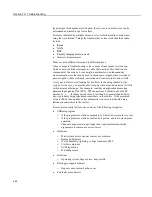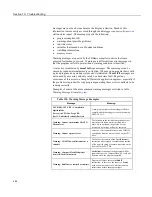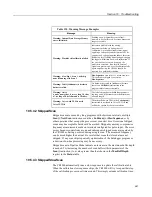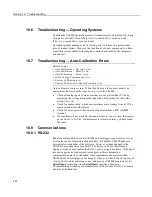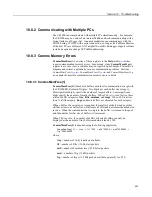
Section 10. Troubleshooting
10.8.2 Communicating with Multiple PCs
The CR1000 can communicate with multiple PCs simultaneously. For example,
the CR1000 may be a node of an internet PakBus network communicating with a
distant instance of
LoggerNet
. An onsite technician can communicate with the
CR1000 using
PC200W
with a serial connection, so long as the PakBus addresses
of the host PCs are different. All Campbell Scientific datalogger support software
include an option to change PC PakBus addressing.
10.8.3 Comms Memory Errors
CommsMemFree()
is an array of three registers in the
Status
table
(p. 603)
that
report communication memory errors. In summary, if any
CommsMemFree()
register is at or near zero, assistance may be required from Campbell Scientific to
diagnose and correct a potentially serious communication problem. Sections
CommsMemFree(1)
(p. 491),
CommsMemFree(2)
(p. 492),
and
CommsMemFree(3)
(p.
explain the possible communication memory errors in detail.
10.8.3.1 CommsMemFree(1)
CommsMemFree(1):
Number of buffers used in all communication, except with
the CR1000KD Keyboard Display. Two digits per each buffer size category.
Most significant digits specify the number of larger buffers. Least significant
digits specify the number of smaller buffers. When
TLS
(p. 531)
is not active, there
are four-buffer categories:
tiny
,
little
,
medium
, and
large
. When TLS is active,
there is a fifth category,
huge
, and more buffers are allocated for each category.
When a buffer of a certain size is required, the smallest, suitably-sized pool that
still has at least one buffer free will allocate a buffer and decrement the number in
reserve. When the communication is complete, the buffer is returned to the pool
and the number for that size of buffer will increment.
When TLS is active, the number of buffers allocated for
tiny
can only be
displayed as the number of tiny buffers modulo divided by 100.
CommsMemFree(1)
is encoded using the following expression:
CommsMemFree(1) = tiny + lil*100 + mid*10000 + med*1
lrg*100000000
where,
tiny
= number of 16-byte packets available
lil
= number of little (≈100 bytes) packets
mid
= number of medium size (≈530 bytes) packets
med
= number of big (≈3 kB) packets
lrg
= number of large (≈18
kB) packets available, primarily for TLS.
491
Summary of Contents for CR1000
Page 2: ......
Page 4: ......
Page 6: ......
Page 32: ......
Page 36: ......
Page 38: ......
Page 40: ......
Page 60: ...Section 4 System Quickstart Figure 16 PC200W View Line Graph 60 ...
Page 96: ......
Page 98: ...98 ...
Page 302: ......
Page 453: ...Section 8 Operation Figure 115 Using the Keyboard Display 453 ...
Page 456: ...Section 8 Operation Figure 118 Real Time Custom 456 ...
Page 457: ...Section 8 Operation 8 8 1 3 Final Memory Tables Figure 119 Final Memory Tables 457 ...
Page 458: ...Section 8 Operation 8 8 2 Run Stop Program Figure 120 Run Stop Program 458 ...
Page 460: ...Section 8 Operation Figure 122 File Edit 460 ...
Page 461: ...Section 8 Operation 8 8 4 PCCard Memory Card Display Figure 123 PCCard CF Card Display 461 ...
Page 478: ......
Page 506: ......
Page 536: ......
Page 636: ......
Page 642: ......
Page 644: ......
Page 676: ......
Page 677: ......




